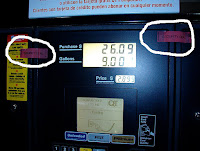In the early days of skimming, the bad guys also had to set up a hidden camera to be able to record the victim's 4-digit PIN code. Armed with the PIN code and the magnetic strip information, the thief had all that was required to compromise a bank or credit card account. To thwart the crooks at, say, an ATM, even if a skimmer was attached to the machine, by simply covering the key pad with your other hand while entering your PIN you could effectively block the view of the spy camera. No PIN number, no matter if the magnetic data was captured, it's useless to the thief.
But authorities report that card skimming crooks have gotten smarter. In addition to mounting a card skimmer on an ATM slot, clever crooks are also installing a keypad overlay. Mounted directly over the ATM's existing keypad, the crook's overlay simply records your keystrokes as you enter your PIN code, and, presto! No matter if you cover the view of the keypad, all of your information has been compromised. Other advances in crooked technology include skimmers that transmit your data electronically – the thief doesn't have to come back to the crime scene to pick up his equipment to get your data – he just receives it electronically, from a safe distance.
So what are we to do to protect ourselves – and our financial accounts? It's getting more important to use that inner sense of "something's not right here." We have the innate ability to see when something just doesn't look or feel right. Here are some tips:
 |
| Materials and color different -- could be a skimmer. |
 |
| Tamper evident fuel pump seals |
With pumps or ATMs, give the parts a good wiggle. These machines are built solidly, and if the card slot or the keypad has "give" when you grab it and give it a pull and a shake, something may be amiss.
When using a fuel pump, you're better off using a credit card, or use your debit card as a credit card. It's much safer to have to enter your zip code than your 4-digit pin code. And you're generally safer going inside to pay, rather than paying at the pump. Although some crooks have been able to compromise in-the-store card readers, it happens far less often.
And by all means, keep a close watch on your credit and bank account records. If you have online access to your accounts, check them regularly for any suspicious activity – and if you find it, report it immediately. Even if your card is compromised, you're not responsible for the charges, provided you report them in a timely fashion.
photos: ATM -- angusf on flickr.com Fuel pump seal -- Average Jane on flickr.com
2 comments:
Thank you for the concise information regarding skimmers and what to look for. I work for a bank in the Debit card area and spend a lot of time talking with customers that have their cards compromised and processing disputed, fraudulent, transactions. Wish they could read your tips.
I was told by a credit card company employee not to use an ATM card at all outside of the bank. Thieves are just too sophisticated these days. I just use my credit card, and although it has been compromised a few times, there is no liability. Additionally, they contact me whenever there is something unusual being charged.
Post a Comment